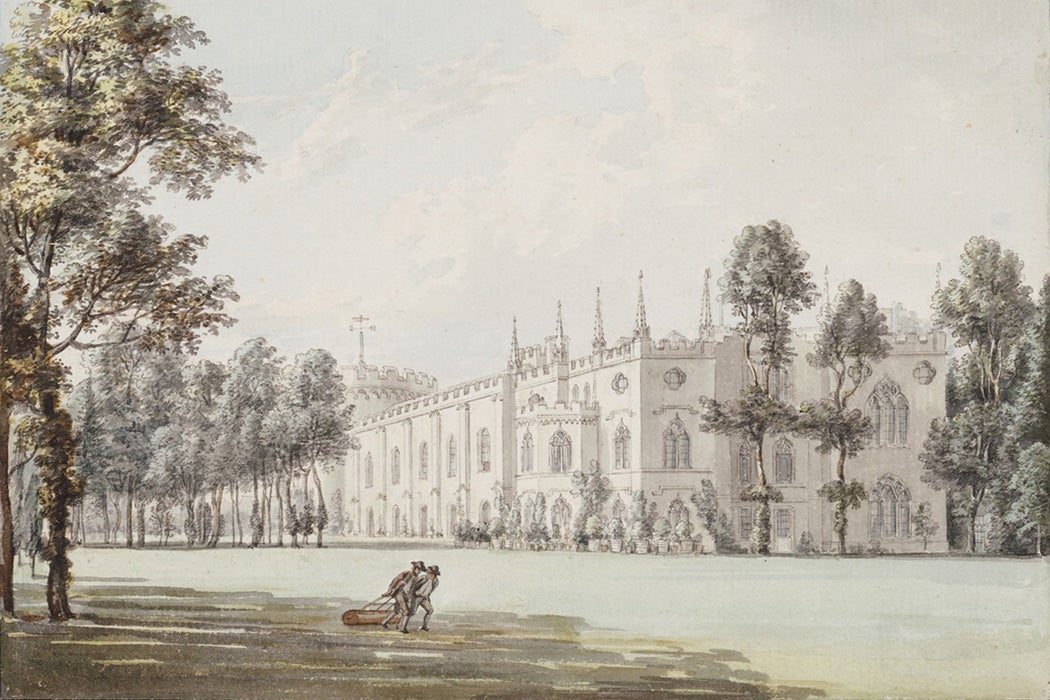The eighteenth-century British aristocrat Horace Walpole’s villa Strawberry Hill, a Gothic confection near London, is a highlight of any introduction to Western architecture. But it also says a lot about Walpole and his “sexual subjectivity,” according to scholar Matthew M. Reeve.
The villa was “a safely disguised projection of his erotic self,” writes Reeve. Walpole “frequently allude[d] to his house as a lover to whom he was singularly faithful,” and his architecture was interwoven with the new formation of a new category of sexual being.
This was a “third sex” that was “neither male or female.” Reeve argues that it foreshadowed “the modern category ‘homosexuality.’” It was based “in part on the perception of a mixture or corruption of genders: the adoption of ‘female’ manners rendered males effeminate, a regular adjective for men of the third sex.”
In his time, critics of Walpole and Strawberry Hill merged architecture and sexuality in a discourse of “degeneracy.” The prominent historian Thomas Babington Macaulay said that the “grotesque house with pie-crust battlements” was the product of Walpole’s “diseased and disordered mind.” Another typical critic ascribed Walpole’s architectural and personal “whim and foppery” to his very “nature.” Palladian classicism, meanwhile, was, in the words of one of its most famous practitioners, Inigo Jones, “masculine and unaffected.”
So what exactly made Strawberry Hill’s architecture so suspect? It was Walpole’s contemporary interpretation of the Gothic aesthetic. As Reeve explains, “Gothic’s appeal—both as a period and as a style—lies in its appeal to the senses and the imagination; it is a style of aesthetic excess, sensory enrichment, and libidinal pleasure, in contrast to the purely intellectual attraction of classicism.” Walpole’s Gothic represented a period of liberty, or “‘freedom’ to extend beyond politics to embrace a wider range of sensory, erotic, and emotive states of being.”
Walpole even sparked the name of the Gothic literary tradition with his most famous work, The Castle of Otranto: A Gothic Story (1764–65). Within the genre, “unsanctioned erotic fantasy from the eighteenth-century English present” was disguised and transported back in time “to a Catholic, medieval (and frequently foreign) past.” In this way, Strawberry Hill’s Gothic design also encoded the forbidden.
The “licentiousness” attributed to Horace Walpole referred to his villa, his fantasy of the Gothic Age, and his sexual self. Walpole would essentially be “outed” in 1764 in William Guthrie’s Reply to the Counter Address, which revealed Walpole’s love for his male cousin. After this, Walpole tried to make himself, as he put it, “more manly,” to counteract the political, moral, sexual, and aesthetic attack launched against him.
Weekly Newsletter
“The relationship between patron and building can now be usefully understood as a doubling of Walpole’s self: a projection of Walpole’s ego that was the subject of his narcissistic desire, while also ensuring his immortality after his death,” writes Reeve.
Strawberry Hill, which Walpole called his “closet” more than once, underwent a major renovation at the turn of this century and is open to the public (in non-pandemic times). We will never know whether Walpole’s bid for immortality will ultimately be successful, but this particular monument has now lasted more than two centuries.
Support JSTOR Daily! Join our new membership program on Patreon today.







